On Support for Artists: Sasamoto Aki x Kamiya Yukie
February 17, 2023
The Agency for Cultural Affairs' Art Platform Program (APJ) has organized international symposiums and provided grants to artists who have gained important opportunities through their international reputation. New York-based artist Sasamoto Aki talks about what kinds of support are most helpful for artists, as well as her hopes for the future. She was interviewed by Kamiya Yukie, who represented the steering committee for APJ (Titles omitted).

The Venice Biennale connected me to a world I never knew existed
Kamiya Yukie (Below, Kamiya): APJ, a five-year pilot project, has provided grants to artists such as yourself to support their international activities. One of those [grants] was for the 59th annual Venice Biennale, which took place in 2022. Can you start by telling us a little about how you prepared for that event?
Sasamoto Aki (Below, Sasamoto): The first time I was approached [about this opportunity] was about a year ago, in the summer of 2021. I had never been to Venice before, and the curator recommended that I go and see it for myself, even if it was just for a day. This curator is someone who has known me for a while, and she told me, ‘just go and see it, and I promise I’ll give you a space where you can do whatever you want.’ So I went when I was starting a new work completely from scratch.
Kamiya: It was a completely new work?
Sasamoto: Yes. I think I got really lucky in this case, because the curator and I already had a preexisting relationship. We were both in New York, and the galleries representing me had experience showing work at international art fairs like Basel.
Kamiya: It’s great that you already had that foundation of knowing each other.
Sasamoto: True, though things got a lot harder once I envisioned the work I wanted to exhibit. Figuring out how to transport [the artwork], the spread of COVID—there were so many elements out of my control, and it really turned into a huge project. I couldn’t have done it without financial support, and a lot of help from other people.
Kamiya: I can imagine the logistics would be a challenge—Venice is surrounded by lagoons, after all, and it’s quite geographically remote to begin with. And then you made this large-scale artwork Sink or Float on top of all that. Where did this idea to use snails as a material, and a kinetic work at that, come from?
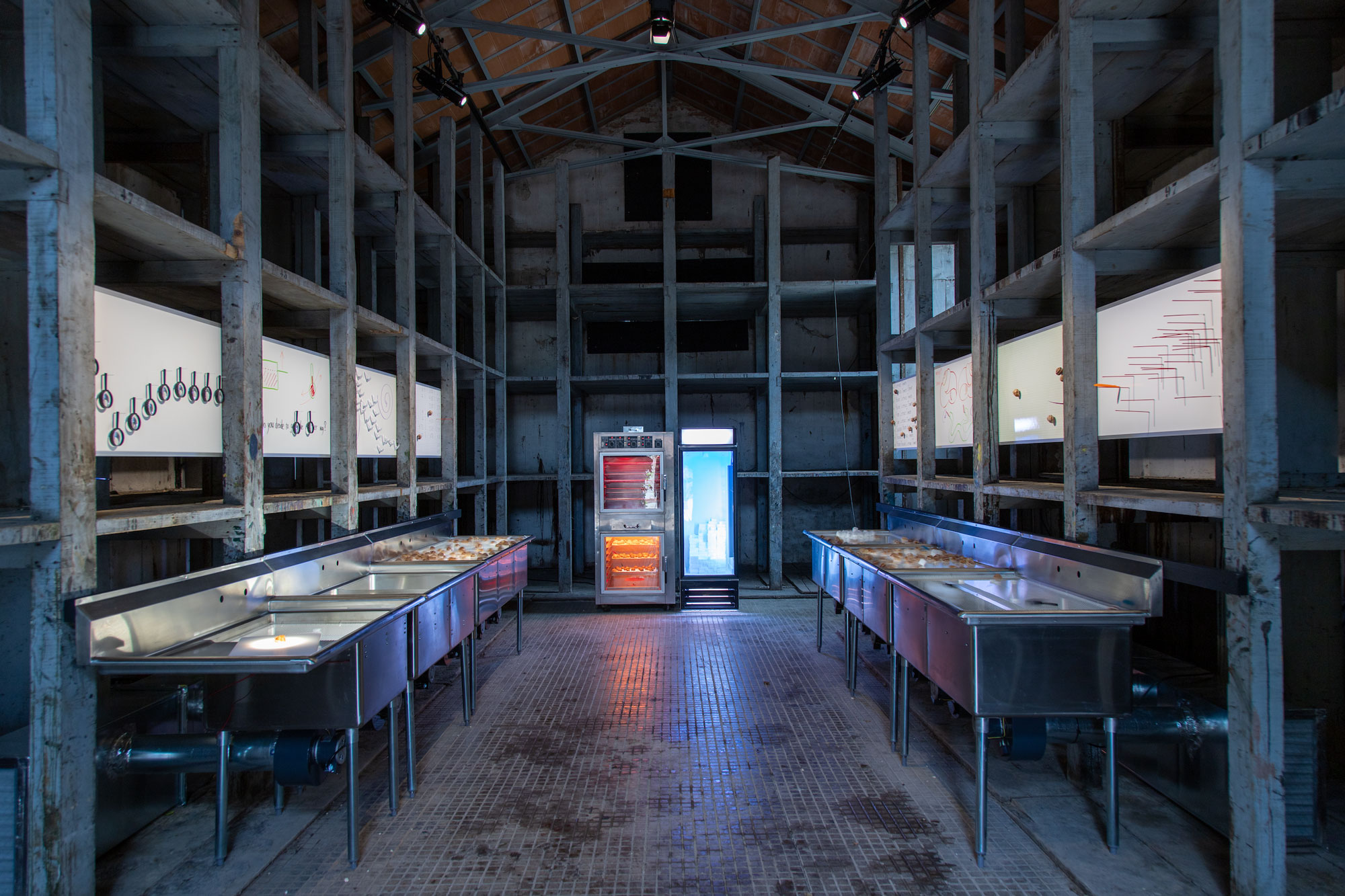 Installation view of Sink or Float at Biennale Arte 2022: The Milk of Dreams
Installation view of Sink or Float at Biennale Arte 2022: The Milk of Dreams
Photographed by Wolfgang Träger / ©︎ Sasamoto Aki / Courtesy of Take Ninagawa, Tokyo and Bortolami, New York
Sasamoto: They wanted me to make a work that didn’t require me to physically be present for the exhibit—I guess you could say it was a request somewhat unique to the Venice [Biennale]. The exhibition period is seven months, so they said even if people in the art world saw my work at the opening, the rest of the exhibition period might not go as well if the work required me to be there.
Kamiya: Seems like it was a new challenge for you.
Sasamoto: It was. Some of my works are purely performance-based, while others are strictly object-based, so I was interested in what kinds of gradations could be imagined between those two extremes. In any case, I think I was able to cut corners a bit [on this request] because the curator was a long-time friend. I just made what I could, then thought about how to lighten the elements [of the piece] afterward.
Kamiya: When I think about the Venice Biennial, what comes to mind are people such as Morimura Yasumasa, Miyajima Tatsuo and others who were invited to the "Aperto" division for the first time in 1988. It turned out to be an important opportunity for introducing contemporary Japanese art and artists to the global art world. Did you experience any new challenges, different to what you’ve experienced in the past, through your participation in Venice?
Sasamoto: I’ve mostly lived in the US since I came here to study abroad during college in 2000, and I hadn’t had many opportunities to exhibit my work in Europe. In that sense, I think exhibiting at Venice was a good introduction for me.
Kamiya: Do you feel like it expanded the scope of your practice?
Sasamoto: I do feel that way, yes. Though this wasn’t a performance-based piece, I think the moving snails provided an element of performativity, so it was a good representation of my work in that sense. And since the theme of the show was “the body,” I felt that the viewers were focused on that aspect of the work anyway.
* “The Expression of the Body and its Transformation,” “The Body and Technology,” “The Body and the Earth” were the three major themes
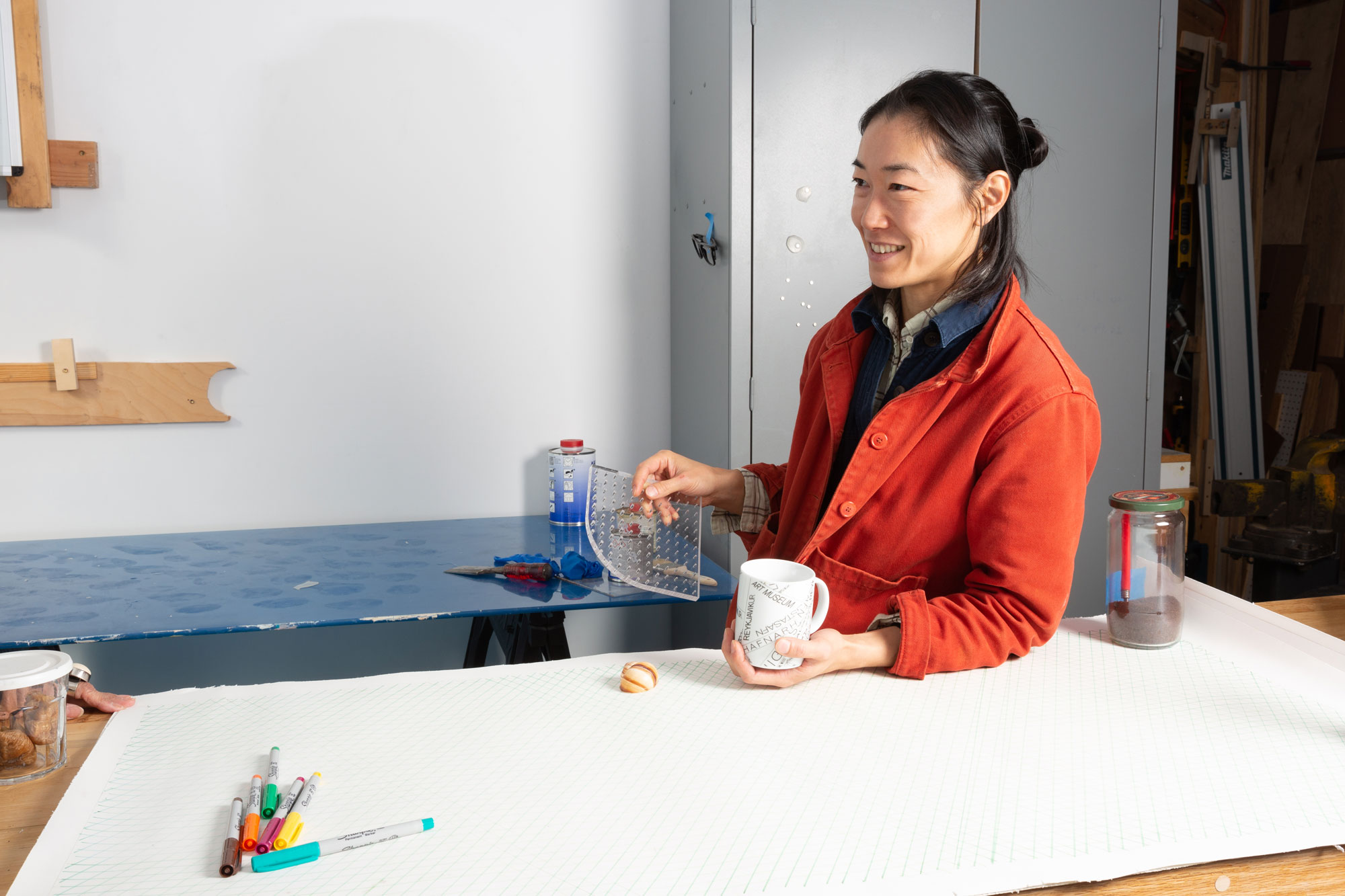 Sasamoto Aki
Sasamoto Aki
The kind of support that artists are seeking depends on what stage they’re at in their career
Kamiya: You’ve been invited to many different residency programs. Are there any examples of new opportunities that came your way through those, or ways you’ve been inspired?
Sasamoto: Early on in my career, I was traveling back and forth between Japan and New York, not knowing where my roots would take me, so it was great to have the grant at that time. I was only expected to do research on a particular theme, so I didn’t have any pressure to do an exhibit or anything. I got two grants—one from the Grant for Overseas Study for Emerging Artists from the Agency for Cultural Affairs (2011‒12) and one from the Pola Foundation for the Promotion of Art (2013‒14).
Kamiya: What kind of themes were you interested in at the beginning of your career?
Sasamoto: That was a time when the art world was just beginning to be more accepting of performance [art]. There was the Fluxus movement beginning in the 1970’s, but it wasn’t until later when the art world took the idea of incorporating performance more seriously. The retrospective exhibit on Marina Abramovic’s work was an example of this.
Kamiya: Yes, many museums were trying to establish performance as a legitimate field of art by creating performance departments, or including performance pieces in their collections.
Sasamoto: Yes, absolutely. It felt similar to when media art was first incorporated into museums. All over the art world, curators and professionals in nonprofit art spaces were beginning to talk about performance as a new department of art. I was still a young artist then at the beginning of my career, but I was able to participate in many of those conversations thanks to the fellowship I received from the Ministry of Culture. In 2021, I took part in the Atelier Calder residence program. I was nominated for this, but thankfully I wasn’t asked to produce any kind of exhibit from this, either.
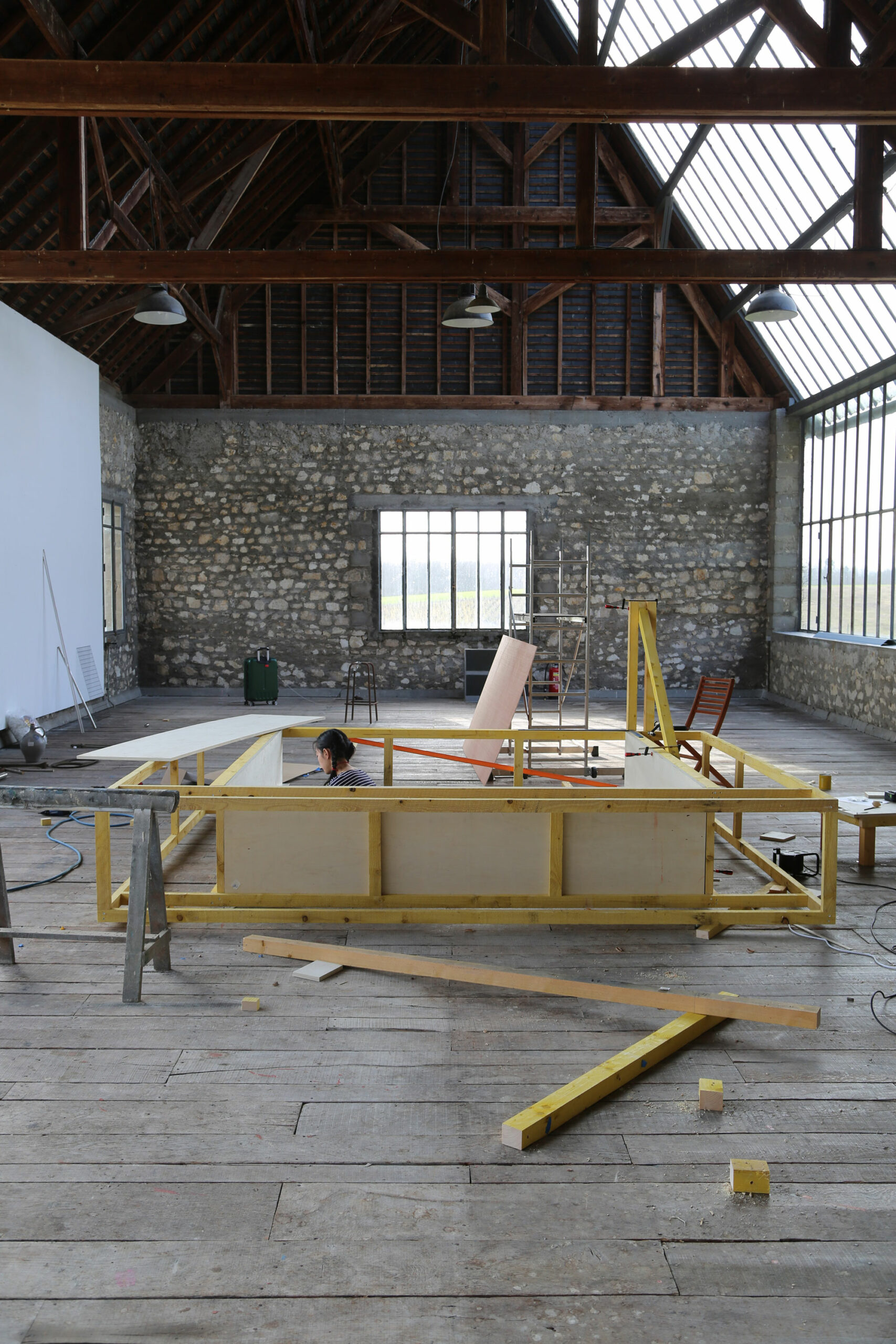 Studio shots from the residency at Atelier Calder ©Sasamoto Aki
Studio shots from the residency at Atelier Calder ©Sasamoto Aki
Kamiya: It seems like this free, unstructured time really set the stage for what was to come.
Sasamoto: Well, at the end of the day, an artist has to make something. So even if you haven’t decided what you are going to make at the time you receive the grant, you would give credit to the residency when you made the work. That’s the kind of program it was. There is always pressure [on an artist], it’s just that I was able to have more control because I could work at my own pace. The residency required me to be in the studio for six months. I didn’t have to make anything, I just had to be there. So I thought that was something I could do, and I decided to take the opportunity.
Kamiya: Since that residency is in quite a remote area away from the city, it must have been a good environment for thinking and making.
Sasamoto: There were no other artists, so it really did feel like I had that time all to myself. I really felt the residency was more effective because it didn’t schedule too many programs where the artists had to interact with different people.
Kamiya: Do you think that you can take more risks as an artist when you are simply given free time and space?
Sasamoto: It depends on what stage you’re at in your career. I think having a very unstructured environment is probably better for mid-career artists. Since the residency needs to take credit for the results it produced, the artist needs to make sure they show those results after the residency. For an artist who’s just starting out, it might be more helpful to have a research grant, or pre-programmed events.
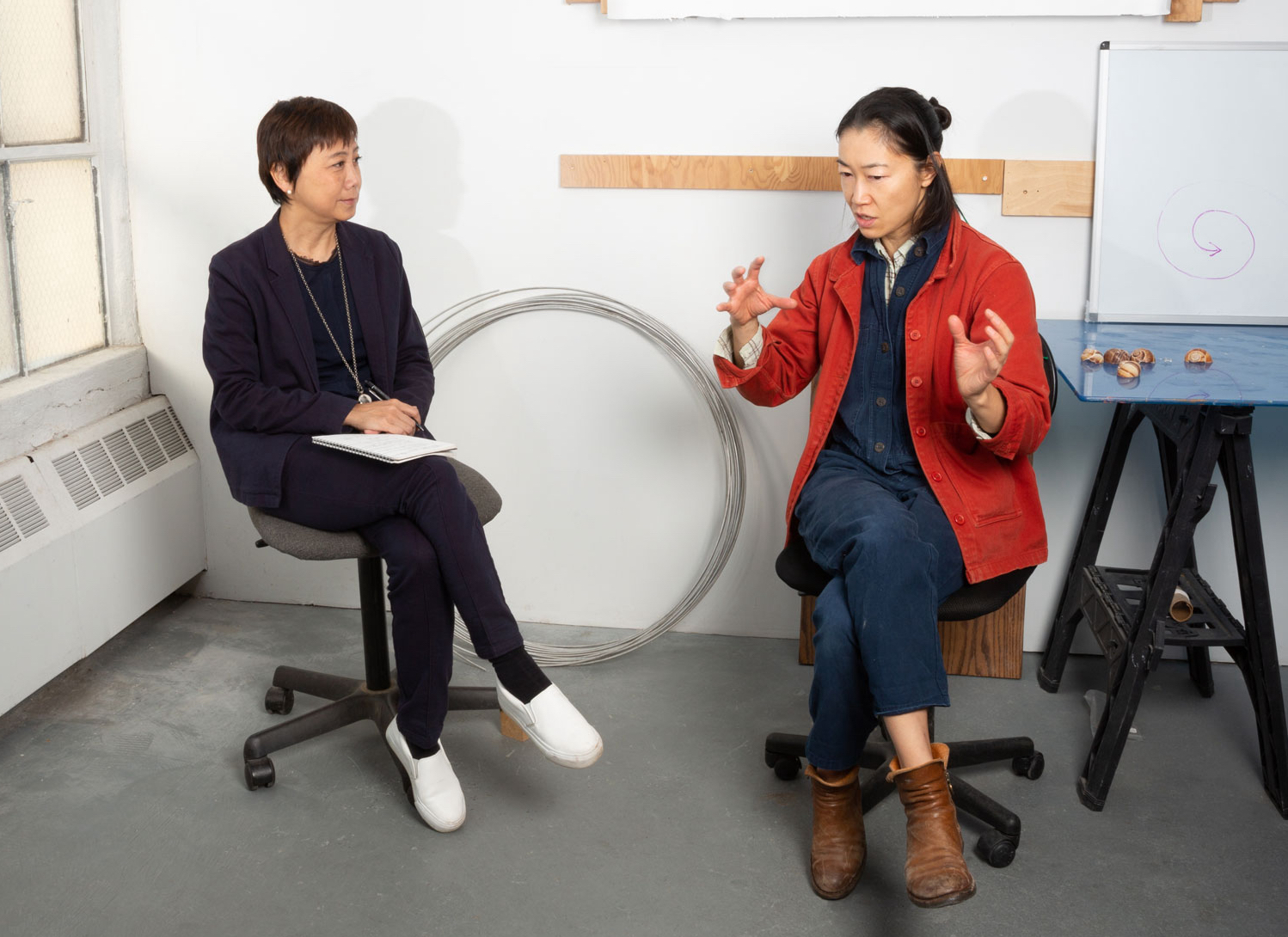
University, grants—everything is just an introduction
Kamiya: In the fall of 2020, during the pandemic, you took part in an online project, called “From Here to There” (organized by the Japan Society New York). It wasn’t a recorded video but a live performance streamed on a virtual platform, and you made the program with a group of students you were teaching at Yale. As an artist, have these virtual experiences impacted your on-site projects at all?
Sasamoto: I see virtual platforms as just one kind of media. Under special circumstances [like during Covid] you have to use your imagination. The benefit of that was being able to connect with people from far away. You have to take advantage of that kind of opportunity. I think it was a very timely project in that sense.
Kamiya: It really was like discovering a new continent. Seeing what we could do under those new circumstances.
Sasamoto: In order to have people empathize with a new project, there’s some things you can’t know until you actually do them. Then it’s just a question of who will provide the impetus. It could be one of my students, which would make me very happy, or it could be someone who saw the work. There are always people who are willing to dig deeper, and whoever that is will be the one to create a new world.
Kamiya: So you’re saying it’s about actually doing something first, and then sharing information with each other.
Sasamoto: Everything I teach in college is just an introduction. I just show [the students] the first door. And then the students have to pass through the door, and begin digging—that’s what I think. They don’t have to follow me to the deepest places, that would be boring anyway. Especially with art, you can’t apply yesterday’s definitions to today’s works. You just show them a bunch of doors, give them an introduction.
 Kamiya Yukie
Kamiya Yukie
Kamiya: I guess these grants are a kind of introduction too. It gives [the artist] a chance to start digging into something, but whether they use that opportunity is up to them, or the institution. Not every single opportunity will become a gem, but you have to take them anyway. I’m sure that teaching alongside doing your own art practice takes up a lot of time, but is there something you’ve learned from teaching as an artist?
Sasamoto: Teaching allows me to see a lot of different doors. Each student brings their own unique interests to the classroom, so my role is to say, well, then what about A or B or C? But I have to connect with a lot of different people. Yale is a research university, so I get to meet people from different fields. For example, I might meet someone in the engineering department, or in history. I interact with them, connect with them, and then have the students do the actual excavating. I don’t have to do that myself. I feel lucky just to see the results from an indirect perspective.
Kamiya: Seeing so many different doors must be stimulating. It seems like teaching is useful in that way.
Sasamoto: It’s important to draw firm boundaries. If I try to follow a student down their path just because it seems interesting, I might clash with them. Human beings are like siblings, after all. Humanity is a giant organism. Artists collaborate with various disciplines and fields of study to think about the future of art and in that way do things that people in other fields can’t do. I think that the university is a place where we can do things like that. So, being an artist and a teacher seems similar, yet they’re also completely different.
Kamiya: But they are part of the same world.
Sasamoto: Yes, exactly. How do I show students that there are connections between so many different things?
Kamiya: And the preparation you do for that feeds back into your practice, in many senses.
Sasamoto: Presenting a work of art you’ve created and presenting a curriculum are quite similar. The structures are different, but neither can be done alone. How can we act at the level of institution to develop the field?
Connections between different fields, eras, and cultures open new, hybrid paths.
Kamiya: Beginning in 2023, the next fiscal year, APJ will become part of the National Art Research Center (tentative name, hereafter Research Center) which will take on many new projects. As an artist, do you have any hopes or wishes for the future of research centers in Japan? Currently, one of the plans is to provide financial support for the creation of major new works that will be shown at exhibitions.
Sasamoto: I’ve benefited a lot from these kinds of grants, as most of the time I wouldn’t be able to exhibit [my work] without some kind of financial support. On the other hand I think the kinds of projects that support groups, rather than just individuals, are great—whether through art galleries or organizers. And in terms of making art works, I think residencies like Atelier Calder, which support artists regardless of whether they make an exhibitable work or not, are good too. You have to keep those strictly separate, otherwise artists will get confused.
Kamiya: Is it artistic production, or exhibition? If the goal is artistic production, is it better not to have a predetermined goal?
Sasamoto: Well, making art to be exhibited and making art just in the studio are two different things. Goal-oriented production costs money, so it’s different. Another thing is that artists today create without thinking about how their work will look five years from now. I think if you had a friend in [art] preservation, for example, it would make all the difference. Those kinds of connections are helpful. In the past, artists had to be their own conservators.
Kamiya: I see.
Sasamoto: In Western painting, it used to be that the decisions an artist made would be shaped by how long the plaster lasted. Now we don’t think about that kind of thing at all. I’m not saying it’s bad not to think about it, but when we talk to museum people, it’s just all about curation.
Kamiya: So you’re saying that if you talked about restoration and preservation at an earlier stage, things might be different.
Sasamoto: Well, I’m not saying you need to change the way you make art based on that or anything.
Kamiya: But it’s good to have that knowledge.
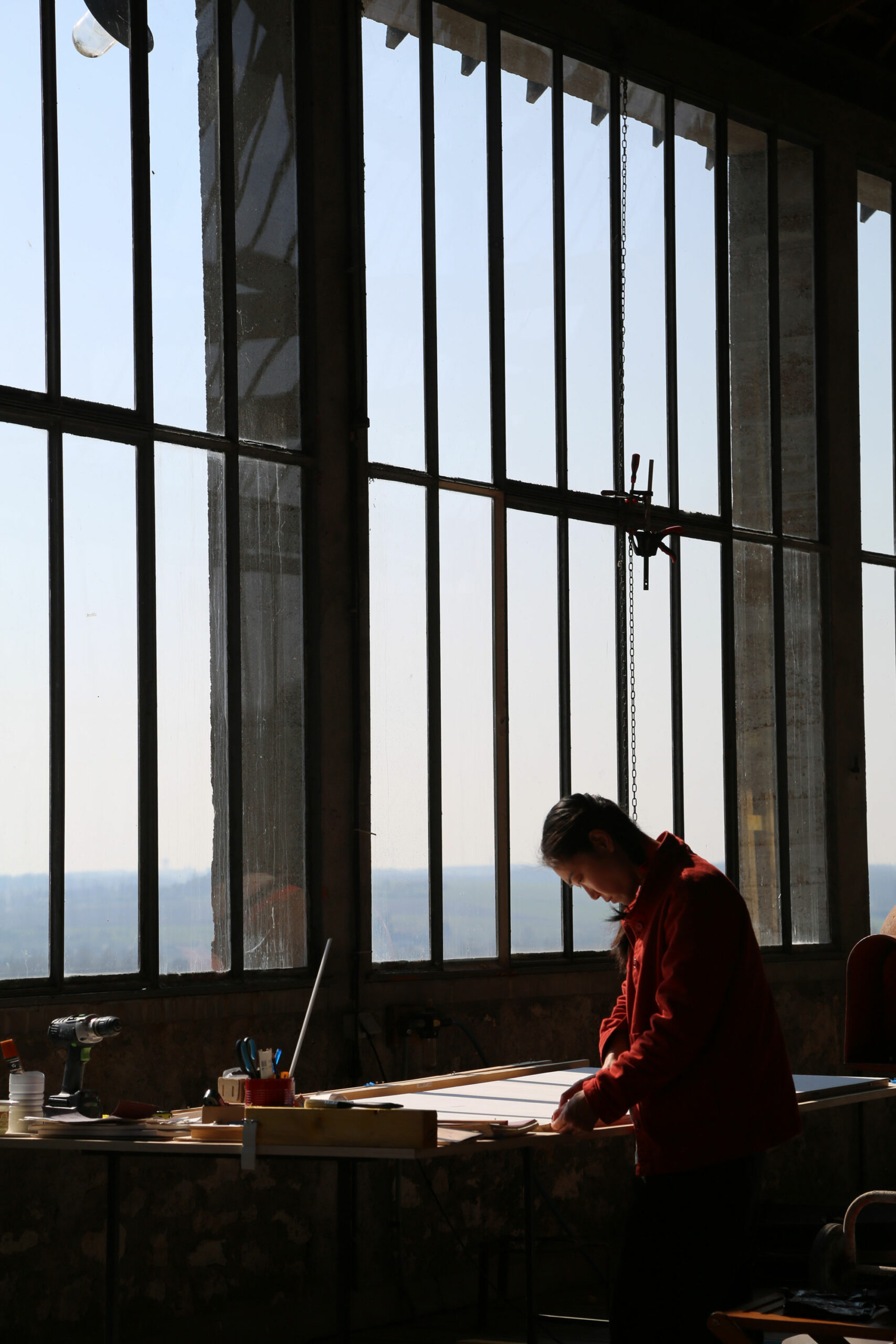 Studio shots from the residency at Atelier Calder ©Sasamoto Aki
Studio shots from the residency at Atelier Calder ©Sasamoto Aki
Sasamoto: The other question is how to get Japanese artists out there. I think it would be good if there were opportunities to learn more about the structure [of the art world] while artists are still in school. It would be better to do this while they are still early on in their career, rather than waiting until they’re already making work. Then the standards will start to change.
Kamiya: If artists knew how they would preserve their performances (as artists) earlier in their careers, I think it would influence their production process. Also having ideas about how to advance their careers or having access to an archive of examples from their predecessors might shape their future career decisions.
Sasamoto: That’s true. Come to think of it, contemporary artists only have themselves and a few generations before as examples. That might prove to be fatal. If you want to contribute to the development of art, you can't just look at the ‘art’ part.
Kamiya: It’s important to consider different time periods. It’s like the way art museums are classified in the modern era. Different museums have been created for different time periods, different types of media—it’s getting more and more fragmented. But I think creating spaces that are cross-temporal and cross-media opens up new pathways for knowledge. If we don’t learn from the past, contemporary art will only become more one-sided. One idea would be to make sure a research center has access to these materials from the past, as well as to different fields.
Sasamoto: And different cultures too. For example, I went to Europe recently, and although the conversations [people were having about art] there were different, I was still able to participate because we are connected by the Euro-American context. But I’m sure there are a lot of other areas that we’re not connected to yet. How do we bridge places that are so different in terms of language or location? How can we skip over Europe and America and collaborate with [artists from] Nigeria, for example? And as an Asian country, how can we make more connections with other places in Asia? How can we connect with places in Latin America, like Brazil? Focusing on non Euro-American regions would be much more interesting. Like how when jazz came to Japan, it created a new kind of fusion music.
Kamiya: If we could create a new hybrid [kind of art], it would mean that the spread of culture from Japan to the rest of the world would become even stronger. Thank you so much for all the suggestions you gave today.
Interlocutor Profiles
Sasamoto Aki: Artist, Chair of the Sculpture Department, Yale University
Born in Kanagawa, based in New York, Sasamoto came to the U.S. in her teens, where she then studied art, dance and sculpture. She received her MFA from Columbia University. Her performances, sculptures, and installations focus on everyday acts and procedures, and she plays various roles in her work, including that of dancer, sculptor, and director. She has collaborated with visual artists, musicians, choreographers, scientists, and academics. Major exhibitions include "Whitney Biennial 2010", "The 9th Gwangju Biennial" (2012), "Delicate Cycle" (2016), a solo exhibition at the Sculpture Center in New York, and "The 59th Venice Biennale International Art Exhibition" (2022). In addition to "Sink or Float," which was exhibited in Venice, this year she exhibited "Sink or Float," her first new sculpture in five years, at Take Ninagawa, and participated in group exhibitions at "Aichi 2022: STILL ALIVE," "Busan Biennale 2022," and "Okayama Art Exchange 2022."
Kamiya Yukie: Curator, Art Critic
Born in Kanagawa, based in New York, Kamiya served as Gallery Director at the Japan Society in New York, Chief Curator of the Hiroshima City Museum of Contemporary Art in Japan, and Associate Curator of the New Museum in New York. She co-curated the 12th Shanghai Biennial (2018-19). Kamiya has organized exhibitions bridging Asia and other regions around cross-temporal themes with an interdisciplinary approach, and curated/co-curated monographic exhibitions on the work of Cai Guo Qiang, Morimura Yasumasa, Ono Yoko, Ozawa Tsuyoshi, Simon Starling, and Do Ho Suh, as well as group exhibitions such as “Discordant Harmony: Critical Reflection on the Imagination of Asia” (2015-18), "Re:Quest Japanese Contemporary Art since the 1970s" (2013) and others. She was awarded the Academic Prize from the Western Art Foundation in Japan (2011). As a member of AICA (International Association of Art Critics), her writings have appeared in many publications, including Hiroshi Sugimoto: Gates of Paradise, Skira/Rizzoli (2017), Ravaged: Art and Culture in Times of Conflict, Mercatorfonds (2014), California-Pacific Triennial, Delmonico Books (2013), and Creamier: Contemporary Art in Culture, Phaidon (2010). She received her BA from Waseda University, and completed the Curatorial Program at De Appel, Amsterdam.
Photos: Ofra Lapid
Edit & Text: Goroku Miwa
Translation: Lisa Hofmann-Kuroda
